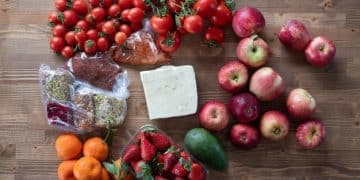Sustainable Eating: Eco-Friendly Food Choices for Health & Planet

Making eco-friendly food choices is vital for both personal health and planetary well-being, encompassing mindful sourcing, waste reduction, and supporting sustainable food systems to create a positive impact on the environment and individual vitality.
In an era increasingly defined by environmental consciousness and a yearning for healthier lifestyles, the concept of Sustainable Eating: How to Make Eco-Friendly Food Choices That Benefit Your Health and the Planet has emerged as a cornerstone of mindful living. This isn’t merely a trend; it’s a fundamental shift in how we approach our food systems, recognizing the profound interconnectedness between what we consume, our personal health, and the ecological footprint we leave upon the Earth. Embracing sustainable eating means making intentional choices that nourish our bodies while also safeguarding the resources and biodiversity vital for future generations.
The urgency for sustainable eating
The global food system, while feeding billions, also presents significant environmental challenges. From deforestation for agricultural land to vast greenhouse gas emissions from livestock, our current methods of food production are often unsustainable. Understanding these impacts is the first step towards embracing a more responsible approach to our dietary habits. Recognizing the scale of the problem is not about fostering despair, but rather empowering conscious choices.
Traditional farming practices can lead to soil degradation, water depletion, and massive biodiversity loss. The reliance on chemical fertilizers and pesticides contaminates water sources and harms beneficial insects. Furthermore, the sheer volume of food waste generated globally contributes significantly to landfill emissions, exacerbating climate change. Addressing these issues requires a multi-faceted approach, starting with individual consumption patterns and extending to policy and industry-level changes.
environmental foot-print of food production
The journey of our food, from farm to fork, has a complex and often considerable environmental impact. This ‘food print’ encompasses various factors, including water usage, greenhouse gas emissions, land degradation, and pollution. Each stage of this journey presents opportunities for improvement and responsible innovation.
- Carbon emissions: Livestock farming, particularly cattle, produces significant methane, a potent greenhouse gas. Transporting food long distances also adds to emissions.
- Water consumption: Agriculture is the largest user of freshwater globally. Producing certain foods, like almonds or beef, requires immense amounts of water.
- Land use and deforestation: Expanding agricultural land often leads to deforestation, destroying critical habitats and reducing carbon sinks.
- Pollution: Runoff from fertilizers and pesticides contaminates water bodies, creating dead zones and harming aquatic life.
Understanding where our food comes from and how it’s produced allows us to make more informed decisions. Opting for locally sourced, seasonal produce, for instance, can significantly reduce the carbon footprint associated with transportation and storage.
Beyond the environmental imperatives, there’s a strong case to be made for sustainable eating as a pathway to improved personal health. Foods produced with less chemical intervention, sourced locally, and consumed in their whole, unprocessed forms often offer superior nutritional profiles. This is not just about avoiding harmful substances but actively seeking out foods that enhance well-being and vitality.
Ultimately, the urgency for sustainable eating stems from a dual imperative: protecting our planet for future generations while simultaneously nurturing our own health and vitality in the present. It’s a holistic approach that recognizes the intricate tapestry of life and our role within it.
Decoding sustainable food labels
Navigating the supermarket aisles can be daunting, with an array of labels promising everything from “natural” to “eco-friendly.” Understanding what these labels truly signify is crucial for making genuinely sustainable choices. Many terms are unregulated, while others signify adherence to strict standards. A discerning eye for certification marks is key.
The proliferation of food labels can create confusion, enabling greenwashing tactics where products are marketed as sustainable without substantive proof. Consumers must become educated on common certifications and their implications, moving beyond superficial claims to understand the integrity behind the promises.
Understanding common certifications
While an exhaustive list of all certifications is beyond the scope of this article, focusing on some of the most recognized and impactful ones can provide a solid foundation for sustainable shopping.
- USDA organic: This label indicates that products are produced without synthetic pesticides, fertilizers, GMOs, or growth hormones. It also ensures animal welfare standards are met for organic meat and dairy.
- Fair trade: Guarantees that producers in developing countries receive fair prices for their goods, promoting sustainable livelihoods and environmental stewardship. Look for it on coffee, chocolate, bananas, and more.
- Marine stewardship council (MSC): Identifies seafood that has been caught sustainably, ensuring healthy ocean ecosystems and fish populations for the future.
- Rainforest alliance certified: Products bearing this seal are sourced from farms that adhere to strict environmental and social standards, promoting biodiversity conservation and sustainable livelihoods.
Beyond these, regional and local certifications often exist, reflecting specific ecological or social considerations. A little research into local food systems can uncover additional trustworthy labels and producers committed to truly sustainable practices. The key is to look for credible third-party certifications rather than self-proclaimed “green” labels.
It’s worth noting that even without specific certifications, smaller local farms or direct-to-consumer operations often employ highly sustainable practices without the overhead of formal labeling programs. Engaging directly with farmers at markets, for instance, can provide valuable insights into their growing methods and commitment to sustainability. This direct connection fosters trust and transparency, moving beyond labels to truly understand the food’s journey.
Ultimately, decoding sustainable food labels involves a combination of knowledge about established certifications and a willingness to investigate and connect with local, ethical producers. This approach empowers consumers to make choices that align with their values and contribute positively to both their health and the environment.

Embracing plant-forward eating
Reducing meat and dairy consumption is one of the most impactful dietary changes an individual can make for environmental sustainability. Livestock farming is a major contributor to greenhouse gas emissions, deforestation, and water pollution. Shifting towards a more plant-forward diet can significantly reduce one’s ecological footprint.
However, plant-forward eating is not necessarily about strict veganism or vegetarianism. It emphasizes increasing the proportion of plant-based foods in one’s diet while reducing, rather than eliminating, animal products. This flexibility makes it an accessible and sustainable approach for many.
The environmental benefits of plants
Plant-based foods generally require less land, water, and energy to produce compared to animal products. This efficiency translates into a significantly lower environmental impact across various metrics.
- Lower carbon footprint: Plant agriculture typically emits fewer greenhouse gases than livestock farming.
- Reduced water usage: Many plant crops, especially pulses and grains, are far less water-intensive than animal products.
- Less land degradation: Plant farming can be more efficient in land use, reducing pressure on forests and natural habitats.
- Biodiversity preservation: Sustainable plant agriculture can support local ecosystems and biodiversity, unlike large-scale industrial farming.
Beyond environmental benefits, a diet rich in fruits, vegetables, whole grains, and legumes is also widely recognized for its profound health advantages. Such a diet is typically high in fiber, vitamins, minerals, and antioxidants, contributing to better cardiovascular health, reduced risk of chronic diseases, and improved gut health. It’s a win-win scenario where personal well-being aligns with planetary health.
Incorporating more plant-based meals doesn’t have to be a radical overhaul. It can begin with simple swaps, like plant-based milk instead of dairy, or opting for a meatless day once or twice a week. Exploring diverse plant proteins like lentils, chickpeas, tofu, tempeh, and various nuts and seeds can open up a world of culinary possibilities beyond traditional meat-centric meals. The key is gradual integration and experimentation rather than abrupt, restrictive changes.
Embracing a plant-forward approach is a powerful way individuals can contribute to a more sustainable food system. It requires an open mind and a willingness to explore new culinary horizons, but the benefits—both for personal health and the planet—are immense and far-reaching.
Minimizing food waste: from kitchen to compost
Globally, a significant portion of all food produced is wasted, contributing to environmental degradation and economic inefficiency. This waste occurs at various stages, from farm to consumer, and tackling it is a critical component of sustainable eating. Minimizing food waste not only conserves resources but also saves money.
The problem of food waste is multifaceted, requiring solutions that address everything from farm-level inefficiencies to consumer habits. However, significant impact can be made at the household level through awareness and simple behavioral changes. Every discarded apple core or forgotten vegetable contributes to a larger systemic issue.
Strategies for reducing household food waste
Empowering individuals to reduce their food waste begins with practical, actionable strategies that can be integrated into daily routines:
- Meal planning: Plan your meals for the week, create a shopping list, and stick to it. This prevents impulse buys and ensures you only purchase what you need.
- Proper storage: Learn how to store different foods correctly to extend their shelf life. For example, some fruits produce ethylene gas that ripens other produce, so they should be stored separately.
- “Ugly” produce: Don’t shy away from purchasing fruits and vegetables that look imperfect but are perfectly edible. Many are discarded due to cosmetic standards.
- Creative cooking: Utilize all parts of your ingredients. Vegetable scraps can make stock, and overripe fruit can be used in smoothies or baked goods.
- Composting: For unavoidable food scraps (like peels or coffee grounds), composting turns waste into valuable soil amendments, diverting it from landfills.
Beyond these immediate actions, understanding expiration dates is also crucial. “Best by” or “sell by” dates often refer to quality, not safety. Many foods are perfectly safe to consume past these dates. Utilizing apps or simple tracking methods to monitor food expiration can also significantly reduce waste.
The journey from kitchen to compost emphasizes a circular economy within our homes. By consciously reducing what we discard and responsibly managing what little we must, we contribute to a healthier planet. It’s a testament to the power of small individual actions accumulating into significant collective impact.
Minimizing food waste is a tangible way to practice sustainable eating on a daily basis. It fosters creativity in the kitchen, encourages economic prudence, and directly contributes to a lighter environmental footprint. It’s about respecting the resources and labor that went into producing our food.
Supporting local and seasonal food systems
Choosing local and seasonal foods forms a cornerstone of sustainable eating. When food is grown close to home and consumed during its natural harvest period, it drastically reduces the environmental burden associated with transportation, storage, and artificial ripening processes. Furthermore, it strengthens local economies and connects consumers with their food sources.
The benefits extend beyond mere environmental impact. Local, seasonal produce is often fresher, more flavorful, and more nutrient-dense. It hasn’t endured long journeys or been picked prematurely to ripen in transit, ensuring peak quality and taste. This freshness directly translates to a more enjoyable and nourishing culinary experience.
The multifaceted benefits of local produce
Opting for local and seasonal foods confers a wide array of advantages, both ecological and societal:
- Reduced carbon footprint: Less transportation means lower fossil fuel consumption and fewer greenhouse gas emissions.
- Support for local economies: Purchasing directly from local farmers keeps money within the community, supporting small businesses and preserving agricultural land.
- Fresher, more nutritious food: Shorter travel times mean produce is harvested at its peak ripeness, retaining more nutrients and flavor.
- Greater food security: A stronger local food system is more resilient to supply chain disruptions and external shocks, enhancing regional food independence.
- Transparent practices: Direct interaction with farmers at markets often allows consumers to inquire about farming methods, pesticides, and animal welfare, fostering trust.
Engaging with local farmers’ markets, subscribing to Community Supported Agriculture (CSA) programs, or seeking out local produce sections in grocery stores are practical ways to incorporate this principle. Such initiatives not only provide access to high-quality, sustainable food but also build a sense of community around shared values.

Understanding which foods are in season in your region is a simple step. Many online resources and local agricultural extensions provide seasonal produce guides. This knowledge can inspire varied and creative cooking, adapting meals to what’s naturally abundant and fresh throughout the year.
Supporting local and seasonal food systems is a powerful way to vote with your fork. It’s an investment in environmental health, community resilience, and personal well-being. It reconnects us to the natural rhythms of the land and the people who work to feed us, fostering a deeper appreciation for our food.
Conscious consumption and mindful eating
Sustainable eating isn’t just about what we eat, but also how we eat. Conscious consumption and mindful eating practices encourage us to be more aware of our food choices, their origins, and their impact. This holistic approach extends beyond the plate to our purchasing habits and relationship with food.
In a fast-paced world, eating often becomes an unconscious act, driven by convenience or habit. Mindful eating, by contrast, invites us to slow down, savor our food, and truly connect with the experience. This deeper engagement naturally leads to more discerning and sustainable choices.
Principles of conscious consumption
Adopting conscious consumption habits means making deliberate choices that reflect ethical and environmental values. It’s about moving from passive consumption to active participation in a more sustainable food system.
- Understanding sourcing: Research where your food comes from. Are the producers ethical? Are their practices environmentally sound?
- Reducing packaging: Opt for products with minimal or recyclable packaging. Bring reusable bags and containers when shopping.
- Avoiding overconsumption: Buy only what you need to avoid waste. Be wary of impulse buys or bulk purchases that might lead to spoilage.
- Supporting ethical businesses: Prioritize companies that demonstrate a clear commitment to sustainability, fair labor practices, and transparent supply chains.
- Dietary diversity: Explore a wider range of foods, including less common grains, fruits, and vegetables, to support biodiversity and reduce reliance on monocultures.
Mindful eating, a core component of this philosophy, involves paying full attention to the food we are eating—its taste, texture, smell, and the sensations it evokes. This practice can lead to greater satisfaction with smaller portions, reducing overeating and waste. It also fosters a deeper appreciation for the food itself and the resources involved in its production.
Beyond the personal plate, conscious consumption extends to advocating for systemic change. This could involve supporting policies that promote sustainable agriculture, advocating for better industry practices, or simply sharing knowledge with friends and family. Every voice adds to the collective demand for a more responsible food future.
Conscious consumption and mindful eating are transformative practices. They encourage a more respectful relationship with food, recognizing it not just as fuel but as a vital connection to our planet and communities. This deeper awareness is a powerful catalyst for sustainable living.
The health dividends of eco-friendly choices
The journey towards sustainable eating isn’t solely an environmental imperative; it’s also a powerful pathway to enhancing personal health. Many eco-friendly food choices naturally align with dietary recommendations for optimal well-being. This synergy means that what’s good for the planet is very often good for our bodies.
When we opt for foods that minimize environmental impact, we often simultaneously choose options that are less processed, richer in nutrients, and free from harmful additives. This fundamental connection underscores the holistic benefits of embracing a sustainable diet, impacting everything from energy levels to disease prevention.
Nutritional advantages and health benefits
The health dividends of an eco-friendly diet are numerous and significant:
- Higher nutrient density: Locally sourced, seasonal fruits and vegetables are often harvested at peak ripeness, retaining more vitamins, minerals, and antioxidants compared to produce shipped over long distances.
- Reduced exposure to pesticides and chemicals: Opting for organic or sustainably grown produce minimizes exposure to synthetic agricultural chemicals that may have adverse health effects.
- Increased fiber intake: Plant-forward diets, a cornerstone of sustainable eating, are naturally rich in dietary fiber, crucial for digestive health, blood sugar regulation, and satiety.
- Lower risk of chronic diseases: Studies consistently link diets high in plant-based foods to a reduced risk of heart disease, type 2 diabetes, certain cancers, and obesity.
- Improved gut health: The diverse array of plant foods supports a healthy gut microbiome, which is increasingly recognized for its role in immunity, mood, and overall well-being.
- Sustainable protein sources: Shifting from high-impact animal proteins to sustainable plant-based alternatives like legumes and nuts provides ample protein without the associated saturated fats often found in red meat.
Beyond the specific nutrients, the overall pattern of a sustainable diet—emphasizing whole, unprocessed foods, diversity, and mindful consumption—contributes to a balanced and robust nutritional intake. This contrasts sharply with typical Western diets, which are often characterized by high consumption of processed foods and conventional animal products.
Furthermore, the act of preparing meals with fresh, seasonal ingredients can foster a deeper connection to food and cooking, leading to healthier eating habits overall. This process encourages creativity in the kitchen and reduces reliance on convenience foods that are often high in unhealthy fats, sugars, and sodium.
The health dividends of making eco-friendly food choices are a compelling argument for sustainable eating. It’s a powerful demonstration that nurturing the planet and nurturing ourselves are inextricably linked. By prioritizing planet-friendly options, we simultaneously invest in our long-term health and vitality, creating a virtuous cycle of well-being.
| Key Point | Brief Description |
|---|---|
| 🌱 Plant-Forward Diets | Emphasizing plant-based meals significantly reduces environmental impact and boosts health. |
| 🗑️ Waste Reduction | Minimizing food waste through meal planning and composting saves resources and money. |
| 🌍 Local & Seasonal | Supporting local farms and eating seasonally reduces carbon footprint and enhances food quality. |
| 🏷️ Label Literacy | Understanding food labels helps identify genuinely sustainable and ethical products. |
Frequently asked questions about sustainable eating
▼
Sustainable eating involves making dietary choices that consider their environmental, social, and economic impacts. It’s crucial because our food systems significantly contribute to climate change, resource depletion, and biodiversity loss. By eating sustainably, we help preserve planetary health for future generations while often improving our own well-being.
▼
Not necessarily. While plant-forward diets are highly beneficial for sustainability, sustainable eating is about making conscious choices to reduce your environmental footprint, which can include reducing meat and dairy consumption rather than eliminating it entirely. Even small shifts, like introducing more plant-based meals each week, can make a significant difference.
▼
Reducing food waste at home primarily involves mindful planning and storage. Start by creating weekly meal plans and shopping lists. Store food properly to extend its shelf life, use leftovers creatively, and compost unavoidable scraps. Understanding “best by” vs. “use by” dates can also prevent premature disposal of perfectly good food.
▼
Organic foods generally reduce pesticide use and support soil health, making them a more sustainable choice in many aspects. However, sustainability is multi-faceted. An organic avocado-shipped across the globe might have a larger carbon footprint than conventionally grown, local apples. Combining organic with local and seasonal choices offers the best sustainability balance.
▼
Sustainable eating often leads to a diet rich in whole, unprocessed foods like fruits, vegetables, and legumes, which are high in fiber, vitamins, and minerals. This can reduce exposure to harmful chemicals, support gut health, lower the risk of chronic diseases such as heart disease and type 2 diabetes, and promote overall vitality and well-being.
Conclusion
Embracing sustainable eating is a powerful, multifaceted approach to living that benefits both our individual health and the well-being of our planet. It moves beyond simple dietary restrictions to foster a deeper understanding of our food’s journey and its intrinsic connection to ecological balance. By making intentional choices—from opting for plant-forward meals and minimizing food waste to supporting local farmers and decoding food labels—we contribute to a more resilient, equitable, and environmentally sound food system. The shift to sustainable eating is not merely a trend, but a vital evolution in how we nourish ourselves and steward the Earth, proving that every choice on our plate can make a meaningful difference for a healthier future.





